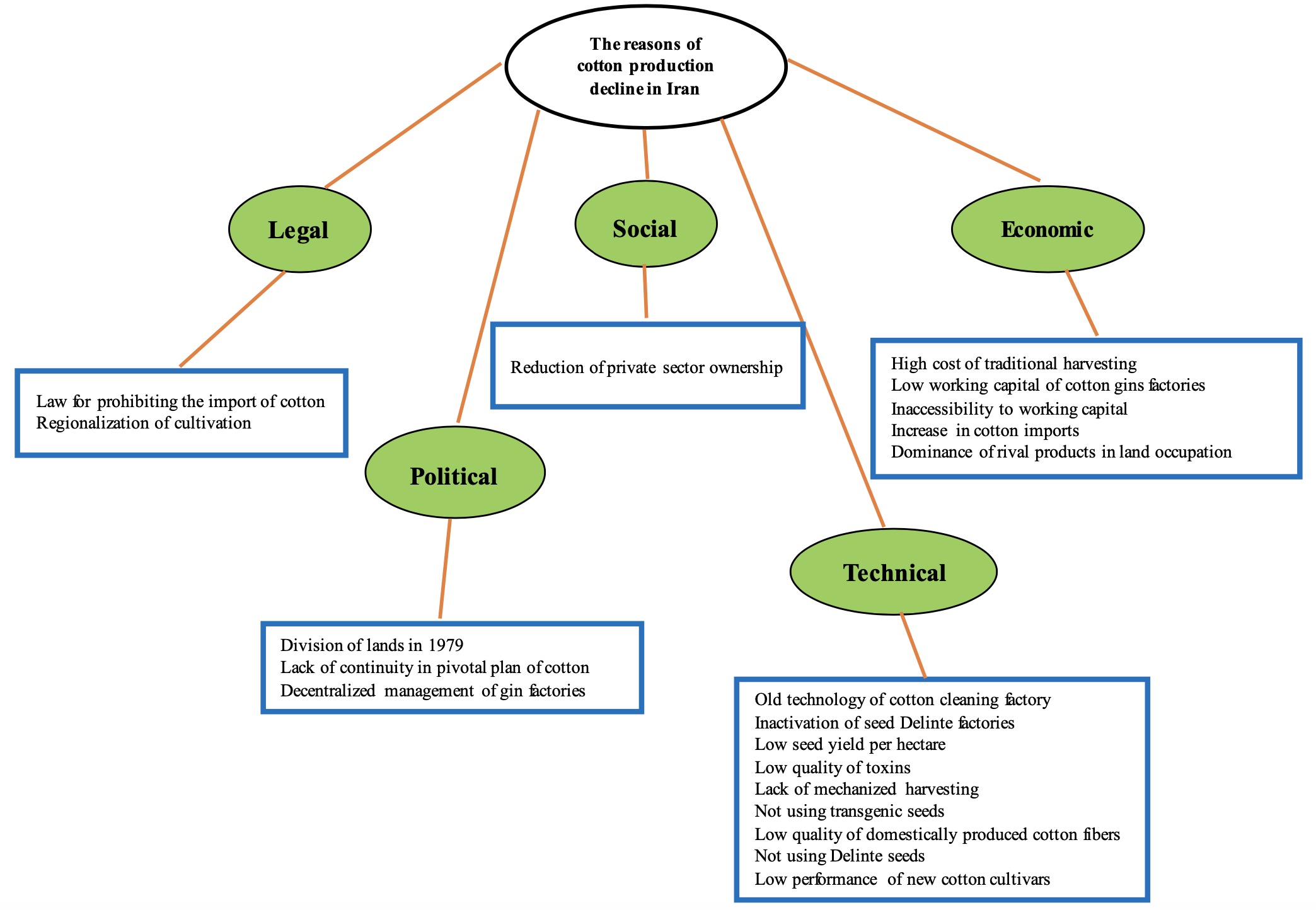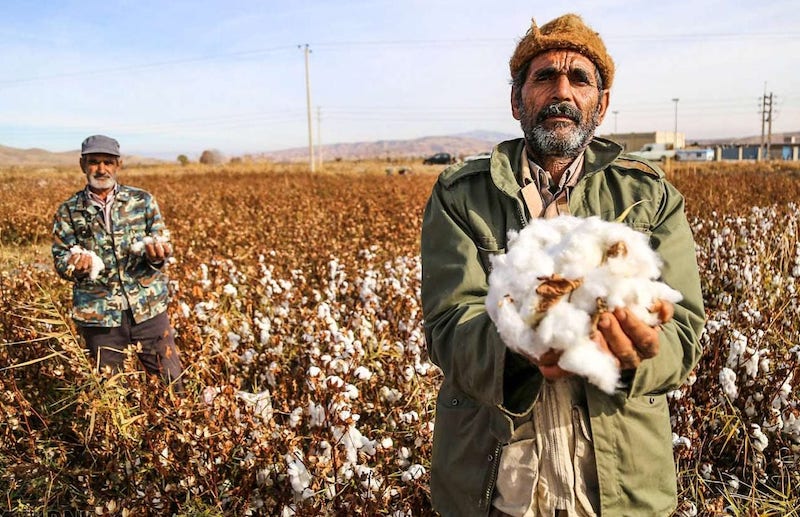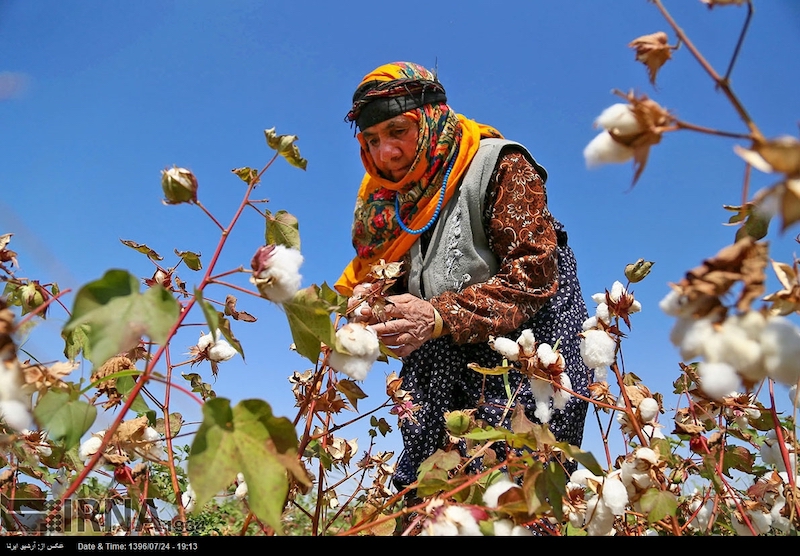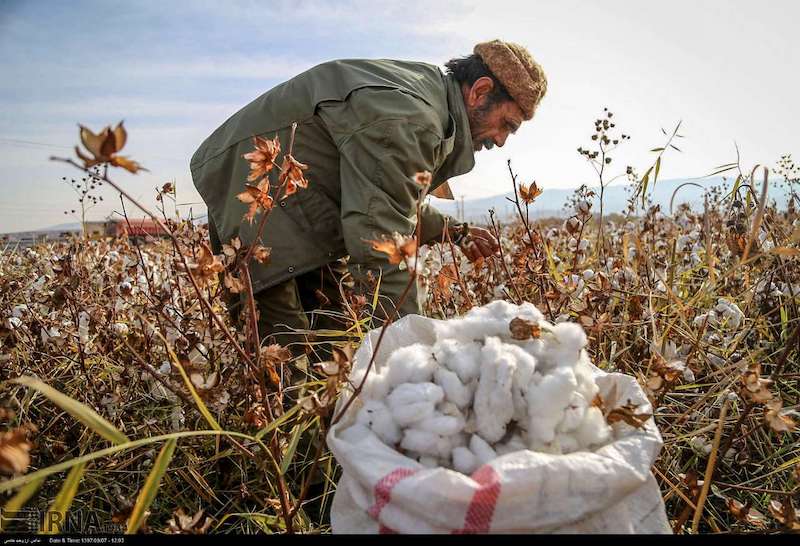Written By: Mahlagha Sadoughi – Kohan Textile Journal – [email protected]
Cotton is a crop and an industrial plant that is used in a wide range of economic sectors and is very important in any economy because of its high employment.
Cotton is called white gold. The history of cotton planting in Iran dates back to Achaemenid era, but despite the long history of cotton planting, the production and the market of cotton in Iran has declined and decreased significantly during recent years for different reasons.
According to statistics, Iran was an exporter of cotton fibers before 1994, but since 2003, the volume of cotton exports has decreased to less than 10%, and after 2010, it has reached zero.
By reducing the area under cultivation from 40% to less than 13% of industrial production, Iran has turned into an importer of cotton.
In 2017, a number of researches were conducted by the Deputy of Infrastructure Research and Production Affairs of the country about the decline in cotton production, which can be referred to economic, technical, political, social, environmental and legal factors. In the following, we will describe each of these factors.

Economic factors of decline of the cotton market
1- High cost of harvesting
Since cotton harvesting in Iran is mostly done manually, the number of labor and consequently labor costs increase in traditional method compared with the mechanized harvesting, harvesting costs increase and profitability decreases and therefore, the tendency to grow cotton in comparison to other competing crops (such as wheat, which requires less labor) is reduced.
2- Low working capital of cotton fin factories
Low profits (about 3 to 4 percent) and long selling times of cotton have made the cotton gin mills unable to repay bank loans with a fee of about 10 percent. This reason caused the factories to use personal capitals or business investment instead of taking bank loans. Therefore, the low cash flow in the cotton gin mills has caused many problems.

3- Dominance of rival products in land occupation
Since cotton is a spring crop with a long growing period, its planting time interferes with other fall crops (such as wheat and barley), and this competition reduces the area under cotton cultivation.
On the one hand, the high cost of cotton production compared to the global average and neighbouring countries has reduced the net profit of this product and on the other hand, more attention to the self-sufficiency plan of wheat and special support for its production has led farmers to cultivate wheat and declination in cotton cultivation has turned it into a competing crop.
Technical factors of declination of the cotton market in Iran
1- Old equipment and machines for cleaning the cotton and import problems
The cotton cleaning machines in Iran are more than 40 years old and date back to before the revolution. They were mainly made in America and its spare parts were the exclusive property of this country.
On the other hand, the sanctions have caused the factories to provide new parts through a third country at a price higher than the original. These factors have led to applying not effective measures to reconstruct and eliminate the defects of the devices, and as a result, the efficiency and quality have decreased and the cost has increased.

2- Reducing the Kil cotton
The ratio between the processed cotton in blowroom machines to the original cotton is called “kil” cotton, which is one of the most important indicators for improving cotton cultivars. In recent years, this ratio has decreased significantly due to reduced seed production and poor harvesting of original cotton.
3- Dispersal of seed Delinte factories
The very fine lint in cotton is called “linte” (In Farsi) which, despite its industrial uses, interferes with the cotton planting process. Modifying cotton seeds and turning them into non-lint cotton is called “Delinte”.
There are limited number of seed Delinte factories in Iran, but the shortcomings after the establishment of these factories and the problems ahead have caused the seed Delinte operation to perform with low quality and not being welcomed by farmers.
4- Low seed yield per hectare
Looking at the area under cultivation and cotton yield in recent years, it can be seen that cotton yield has not only not improved but has also declined during these years. The lack of modification of planting method, poor harvesting method, not using of breeding seeds and reduced seed quality improvement can be the reasons.

5 – Inadequate access to pesticides (daf and drop) and reduction in the quality of pesticides
To use mechanized methods for harvesting cotton, deciduous chemicals must be used before the harvesting operation, but the restrictions for importing these materials into the country in recent years make it difficult for farmers to have access to these chemicals and applying mechanized cotton harvesting methods.
The severe spread of diseases and pests of cotton in Iranian, as well as the low quality of pesticides, have caused farmers to use more and more pesticides, which not only causes more environmental pollution of cotton fields but also increases the cost of the cotton.
6- Restriction of harvesting by mechanized method
Mechanized cotton harvesting is done in two ways: 1- Harvesting original cotton 2- Harvesting the boll.
Harvesting original cotton: Imported combine harvesters are very expensive and have high technology. In this type of harvest, the efficiency and performance of the device depend on the accuracy and quality of the crop. To use this technology, farmers need a lot of support and attention.
Harvesting the boll: Combine harvesting process is not dependent on the accuracy and quality of planting and this method can be used in small and large lands. In our country, it is also possible to produce combine harvesters by boll-picking method, with a reasonable price and good arrangement quality, but limited number of farmers use mechanized harvesting method and most of the farmers harvest cotton mainly traditionally and manually.

7- Not using transgenic seeds
The use of pest and disease-resistant transgenic cotton, while reducing the cost of spraying and the harmful effects of the environment, reduces the cost of cultivation and increases the tendency to cultivate cotton. Since transgenic seeds are not produced in Iran and are imported, the widespread use of these seeds can make the country dependent on the import of these seeds. On the other hand, there are concerns about the long-term effects of using transgenic seeds that limited the widespread use of this type of seed.
Social factors of declination of cotton market in Iran Decrease in private sector ownership
In recent decades, no attention has been paid to the private sector in the cotton industry. The cooperative company of cotton factories has been importing spare parts and packing cotton, researching and studying the process of reducing cotton cultivation and providing a solution. It is hoped that with the entry of the private sector into the cotton industry, the ability and capacity to produce cotton will increase.
Political factors of the cotton market reduction
1- Land division in 1978
Prior to the land subdivision plan, large landowners had control on the cotton growing industry, but after this plan, small plots of land were ceded to people with low managerial skills and expertise. These persons didn’t have adequate specialized financial strength and were unfamiliar with cotton sale market, which led to the transformation of the cotton industry and its collapse.
2- Lack of continuity in pivotal plan of cotton
Due to the importance of cotton cultivation, the dependence of the textile and oil industries to cotton, and the amount of employment it creates in this field, a plan to support cotton cultivation and industry was approved by the Islamic Republic Parliament. But from 1996 and after merging the Cotton and Oilseeds Organization, this support has been removed from the cotton growing industry and attention and support for competing crops such as wheat were increased instead.

3- Destroying of cotton organization
The cotton organization is an organization which is obligated to complete and regulate the cotton cultivation production line. After the revolution, the organization shrank and its operating budget was reduced. On the other hand, the relocation of factories from places with suitable water, such as Golestan province, to arid and unsupervised areas, eventually reduced the quality of cotton fibers.
4- Increasing cotton imports
A significant decrease in cotton production until 2004 led to an increase in cotton imports into the country, but since 2007, with a sharp change in the exchange rate, the amount of cotton imports to the country has increased sharply, which has a devastating effect on cotton cultivation of Iran.
Low import tariffs if cotton, reduction of cash flow in the cotton market, closure of extracting oilseed lines in oil mills and the impossibility of storing cotton seeds in humid regions of the country have led to reduction of cultivation of this crop.
Suggestionsforimprovingcottoncultivation
To improve and increase the cotton cultivation in the country, the following can be suggested:
1. It is better for the country’s policy-making to be community-oriented in the development of agricultural products and avoid paying attention to a specific product and suppressing competing products.
2. Implementing appropriate policies in determining the import tariff of cotton, in a way that in addition to supplying the required cotton for the textile industry, avoinding detrimental effect on the production of this product in the country.
3. Carrying out studies and researches in order to reduce water consumption, improve and increase cotton harvest per unit area and create economic motivation and profitability in cultivating this product.
4. Implementing facilities for the import of new cotton harvesting systems as well as providing mechanized harvesting equipment.
5. Apply facilities to upgrade the equipment of cotton gin factories.
6. Transfer of industrial products to the private sector, organizations and unions.



















